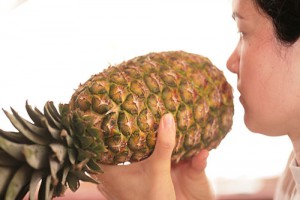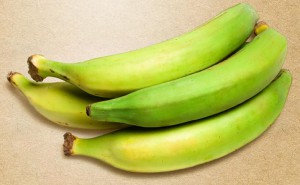-
Featured Posts
- St. Patrick’s Day Pineapple Punch
- Sheet Pan Perfect Pineapple Ham
- Can A Pineapple Really Live Under the Sea?
- Say Aloha to Our Hawaiian-style Ham and Pineapple Pasta Recipe
- Holiday Joy, Hanukkah, and Pineapple Kugel
- What are China’s Pineapple Science Awards?
- Fuel Up with Paleo Pineapple Fried Rice
- Best Gluten-Free Pineapple Upside Down Cake
- Piña Colada Pie in a Jar
- Slow Cooking Your Pineapple This Fall
Tips & Tall Tales
Pineapples: So Versatile, It’s Scary!
With Halloween just around the corner, we thought it might be fun to show our readers a creative alternative to the standard Jack-O-Lantern. Instead of carving a pumpkin this year, try slicing a pineapple into a slightly scarier form.
Like a werewolf during a full moon, The Perfect Pineapple can actually be very spooky once a year and, we think, quite possibly a better candidate for this annual doorstep tradition.
I mean, come on. A pumpkin just brings its roundness to the (carving) table, but a pineapple? A pineapple comes pre-made with a pretty creepy face and a kooky top hat!
Don’t believe us? Give it a whirl tonight in preparation for next week’s big bash. Simply pick up a pineapple at your nearest grocery store and follow these simple steps, demonstrated by this short stop-motion tutorial.
The results might just be terrifyingly good.
Happy Halloween!
Dr. Lloyd
Posted in Featured, Tips & Tall Tales
Tagged DIY, halloween, tips
Keep Heart Healthy
In the United States alone, there are more than 3 million cases of vascular disease reported each year. Often associated with vascular disease are blood clots. Now let’s be fair – blood clots are healthy and lifesaving when they stop bleeding. But they can also form when they aren’t needed. That’s when things get tricky. Blood clots can also cause a heart attack, stroke or other serious medical problems.
Why do blood clots form? Causes of blood clots may include certain heart conditions, pregnancy, prolonged immobility, smoking, certain medications, surgery and inherited blood clotting disorders.
For some of those causes, there’s not much you can do to prevent a clot from possibly happening. But for others, believe it or not, pineapple can help!
A proactive and very natural approach, consuming pineapples has been proven to reduce the risk of blood clots by thinning the blood. Get ready, because here we go with that bromelain again. (It’s a very, very busy enzyme)!
Bromelain helps to trigger an anti-inflammatory response. Because of their bromelain levels, pineapples can help reduce excessive coagulation of the blood. This makes pineapple a good snack for frequent fliers, pregnant women, long-time “sitters” and others at risk for blood clots.
Actually, this is one reason why you will almost always see flight attendants have a full stock of pineapple juice.
Neat fact, right? The more you know!
Dr. Lloyd
Posted in Featured, Tips & Tall Tales
Tagged bromelain, health
The Plantain’s Past
In addition to recipes and prep tips, we at Chestnut Hill Farms like to educate our readers about every aspect of the fruit they purchase from us. It’s part of our company culture. We want our customers to be as passionate about the products we sell as we are! We’re even crazy enough to give those visitors to Lloyd’s Corner a science tutorial on El Niño. (We know…it was a tough one).
Much like our previous post on pineapples, the history of the plantain is fascinating. It’s had its very own world tour. Yet, in this instance, the origins of the plantain can be found on the other side of the globe.
As AfricanFoods.co reports:
“Around 327 B.C, Alexander the Great came in contact with this fruit during his world conquest and introduced it into Europe. The plantain eventually found its way from Malaysia and India to Madagascar through trading Asian and Arab merchants during the Trans-Saharan trade boom… [It] became a very important factor in the wealth, prosperity and rapid expansion of the Bantu Kingdom of central and southern Africa around 1500 AD. To date, the plantain is still a major and popular staple meal across Uganda and the rest of the former Bantu region. The history of the banana and plantain in the Caribbean has also been traced to the activities of the Portuguese Franciscan Monk who is credited for introducing it to the Dominican Republic in 1516, having himself come in contact with this fruit in the Canary Islands, brought there by his compatriots about a hundred years earlier.”
Since then, the plantain has become a staple product in many countries across several continents. From Asia to Africa, to many parts of Latin America, and even among communities in the United States, the plantain is widely eaten year-round.
And now you know!
Dr. Lloyd
Posted in Featured, Recipes, Tips & Tall Tales
Tagged fun facts, history
10 Easy Facts to Understanding “El Niño”
Agriculture is dictated by weather patterns. It might be a very simple fact, but nonetheless essential in understanding what, when and how much produce reaches your local grocery store.
Weather phenomena such as droughts or hurricanes can severely impact what any farm around the world can produce. In Costa Rica, where our farms are based, recent storms have caused workers to press the pause button on much of our vital agricultural practices. These storms, many have claimed, are due to this year’s El Niño event.
In fact, forecasters from the National Oceanic and Atmospheric Administration (NOAA) announced this past month that this year’s El Niño could become among the strongest on record and will likely last into early spring 2016.

So, what exactly is El Niño and why have you heard it before? Here are 10 quick facts you should know!
- “El Niño” is the name of an occurring, temporary change in the climate of the Pacific Ocean.
When someone says there’s an “El Niño” event this year, they’re talking about unusually warm ocean temperatures recorded in the Pacific region around the equator.
- During a non-El Niño year, warm water storms are usually created in the Pacific Ocean and move westward.
To understand how El Niño changes things, first it’s important to understand what’s considered “normal”. In the Pacific Ocean, the water closest to the equator is warmed by the sun. Wind in the region will blow from east (the Americas) to west (Asia and Australia). These gusts of wind—called prevailing winds—take the newly formed warm surface water temperatures with them, making the water near the Americas, as a result, usually cooler by comparison.
- El Niño is a disruption of this “normal” system. During El Niño, trade winds tend to relax and fail to send the rest of the warm air westward.
As a result, warm water builds and builds in the east “until at some point, the system says, ‘Whoa, too much! I’m going to get rid of it!’” Kevin Trenberth, a climate scientist at the U.S. National Center for Atmospheric Research in Colorado, explains. This is when an El Niño event has the potential to kick in.
- The El Niño change is then marked by higher than average ocean surface temperatures in the Pacific Ocean at the Equator, for at least three months.
All of this commotion happening between west and east trade winds results in warmer than normal surface temperatures. This shift in warmth increases the potential of heavy rains, flooding and disrupted fish habitats near the Americas and creates drought conditions in the western Pacific.
- El Niño’s timing usually follows a pattern each decade.
It usually happens every three to seven years, starting slowly in the Northern Hemisphere’s summer, peaking in its winter and dying off quickly in the New Year.
- El Niño translates to “The Christ Child” in Spanish.
Peruvian fishermen are credited with naming the event after they noticed that every few years, around Christmas, virtually no fish could be found in the unusually warm waters.
- Forecasters can quantitatively state how “strong” an El Niño event can be.
Officially, an event is deemed a weak El Niño event if the sea surface temperatures increases by more than 0.5 degrees Celsius (0.9 degrees Fahrenheit) above normal. At 1.0 degree Celsius above normal, an event is moderate, while anything above 1.0 degrees is considered strong. Currently, this El Niño event is reported at 1.5 degrees Celsius above normal.
- Strong El Niño events can have a major impact on global weather phenomena.
More frequent and intense storms and heavy rain and snowfall in certain parts of the United States will usually occur as a result of a strong El Niño winter. An increase in tropical cyclones in the Pacific and decreased hurricanes in the Atlantic can result as well.
- El Niño developed in March of this year.
Many local Costa Rican operations, like Chestnut Hill Farms, have felt the impact of El Niño. As the event continues to strengthen, the region continues to see major rainfall.
- NOAA provides monthly update for El Niño activity.
Can’t get enough El Niño now that you know what it actually is? The National Oceanic and Atmospheric Administration (NOAA) keeps the world abreast of its latest forecasts. Check them out here.
Dr. Lloyd
*Many facts were taken from both the NOAA’s website and a wonderful explanation by Maria Gallucci of the International Business Times. Read her full article here.
Posted in Featured, Tips & Tall Tales
Quick Tip on How to Pick
One of the most common questions I receive here at Lloyd’s Corner is “what’s the best way to slice a pineapple?” We answered that one a while back, but as a refresher course, check out our tutorial here.

Now, the second most commonly asked question – “how do you pick a good pineapple?” – is one we can provide a quick tip for the road. As we’ve said before, and contrary to popular belief, pineapples are at the perfect serving condition right from the store. Yes, you heard that right – yellow OR green, they are always ready to eat.
But if you want to pick the best one of the bunch, a good rule of thumb is to let your nose be your guide. Yup, just smell the bottom of the pineapple! If it has that iconic pineapple fragrance — even if it’s just a hint of pineapple scent— then chances are it’s a good one.
Chestnut Hill Farms is home to The Perfect Pineapple™, so we’re pretty sure you’ll be able to smell any of our fruit right away, but just in case you can’t pick up one of ours, this is your next best strategy.
Happy Picking!
Dr. Lloyd
Posted in Featured, Tips & Tall Tales
Tagged how to
Soft as Pineapple? Yes!
Here on the Corner we’ve spoken plenty of times about the benefits of adding pineapple to your daily diet. Mixing it in a smoothie, letting it soak in your water bottle or simply just chowing down on some juicy chunks are all great ways to take in its magical, medicinal powers. But, what if you wanted to take on a slightly different approach to healthy pineapple recipes? Adding a softer touch to our regular health series, we’re doing just that – featuring reasons why pineapple directly on the skin might just be the next beauty craze.
Applying freshly prepared pineapple juice or crushed pineapple wedges on the face can work wonders as a natural exfoliating agent, eliminating dead skin and accentuating blood flow. The fruit gives the collagen synthesis in your body a boost and the higher the collagen synthesis is, the firmer and flexible your skin will be, safeguarding your skin from looking dull.
As we’ve mentioned before, pineapple is also loaded with Vitamin C. Coupled with bromelain, together these anti-inflammatory vitamin and enzyme found in this fruit can internally, as well as externally, be used as a cure for acne and other inflammatory skin condition. The presence of these amino acids, ensure that the damaged cells and tissues are repaired quickly.
You can also mix about 3 tablespoon of freshly crushed pineapples with an egg yolk and a little milk to give your skin an ultimate hydration effect. Apply it topically on the dry skin and leave it for few minutes. Wash off with tepid water for moisturized, radiant skin.
Enjoy,
Dr. Lloyd
Posted in Featured, Recipes, Tips & Tall Tales
Battling Crohn’s Disease with Plantains
 We’re going to switch it up a bit on Lloyd’s Corner from our usual discussions about pineapple perks to verse our readers a bit more on another versatile fruit we carry here at Chestnut Hill Farms – the all-purpose plantain.
We’re going to switch it up a bit on Lloyd’s Corner from our usual discussions about pineapple perks to verse our readers a bit more on another versatile fruit we carry here at Chestnut Hill Farms – the all-purpose plantain.
For those that aren’t as familiar with plantains, get ready to have your world rocked by what we loving like to call “banana’s big brother.” Starchy and low in sugar, plantains are cooked before eating. This tropical fruit is a staple in Caribbean and Latin American dishes and have inspired a variety of culinary creations, most recently in the United States.
In the next few weeks we’ll be sharing some recipes and fun facts about plantains, much like we have with pineapples. However, this week, we wanted to get right to the nuts and bolts of how beneficial plantains can be for your gut. That’s right, your gut!
Plantains & Digestive Disorders
Discussions about gut health have become more and more popular as, unfortunately, more people are being diagnosed with digestive orders. In North America alone about seven in every 100,000 people suffer from Crohn’s disease – an inflammatory bowel disorder. People who suffer from this disease experience pain and digestive discomfort on a regular basis.
The pain comes as a result of a constant, unnatural battle between the immune system and bacteria (even good bacteria) in the intestines. So as a result, the bowel lining becomes a battleground where the immune system is constantly attacking bacteria that attach to it.
Research now suggests that the soluble fibers from plantain plants may block a key stage in the development of Crohn’s disease. By testing to see if the fibers could reduce the movement of E. coli bacteria across cells lining the bowel, they found that plantain fibers prevented E. coli movement by between 45% and 82%. The lack of movement meant that the plantains were almost “overriding” the Crohn’s need to rid the body of bacteria and as a result fight its effects.
A major win for those dealing with Crohn’s disease in their daily life, the study allows plantains to become a safe and healthy part of anyone’s diet with “sensitive” stomachs.
Interesting to see how fresh produce can help alleviate even the most painful disorders, huh? We will be posting some tasty recipes to make the science a bit more applicable to daily life soon.
Stay tuned!
Dr. Lloyd
Posted in Featured, Tips & Tall Tales
Tagged health
Looking for a Vitamin C Source?
For the average person not as versed in nutritional science, we’re willing to bet that certain vitamins and minerals are associated with one predominant body function – such as calcium and Vitamin D are with bone health or iron with muscle performance. Likewise, certain vitamins and minerals tend to have their own “poster child” in the grocery aisle. In the above example, usually dairy and meat products come to mind.
Among the many nutrients we need to discuss on a daily basis, sometimes overlooked – for all purposes of the word – is the very important Vitamin C. Usually seen as the best way to boost immunity and get over the common cold, Vitamin C also plays a vital role in vision health. And what lip-smacking fruit at your local grocer provides great amounts of Vitamin C? You guessed it – pineapples!
Why is Vitamin C important to eye health? Virtually all cells of the body depend on Vitamin C, including those of the eye where it is actively concentrated in all tissues and supports the health of ocular blood vessels.
Evidence suggests vitamin C lowers the risk of developing cataracts and when taken in combination with other essential nutrients, can slow the progression of age-related macular degeneration (AMD) and visual acuity loss. Poor eating habits, smoking, diabetes and use of steroids have actually increased these risks in recent years, causing experts to believe that rates are expected to triple by 2025 – making Vitamin C intake more important than ever.
Pineapple contains 78.9 mg of Vitamin C, which is actually more than oranges – its usual “spokesfruit.” In addition to its flavorful taste and versatile preparation methods, pineapples have plenty of more health benefits not commonly known.
Want to know more? Take a bite of pineapple today and (excellently) view those other pineapple health facts here.
Enjoy,
Dr. Lloyd
Posted in Featured, Tips & Tall Tales
Tagged health
TALL TALES: Did you know?!
When you visit Lloyd’s Corner you’ll always learn something new about pineapples that you might not have known before. In addition to a collection of recipes (found here), we also strive to bring you some additional information about how this tasty fruit can also influence your lifestyle when made an integral part of your diet.
But the pineapple has so much more to share! This week’s post brings you five fun facts that we’re sure will impress a crowd at your next dinner party:
- How long does it take to grow a pineapple?
Always the most popular at any party, pineapples are by nature fashionably late. One pineapple plant produces a pineapple only once a year. But, it’s sure worth the wait!
- How many pineapples come from the same plant?
It’s a pretty short family tree when it comes to pineapple plants. After a pineapple plant is harvested, this plant will never produce another fruit. However, it will produce daughter plants. Lovingly called little “suckers,” three to four of these new plants will sprout. Only one sucker will be cultivated to bear another fruit while all others will be removed. This second generation plant will produce one more fruit. By the end of two years, two pineapples will have been produced. After the second harvest, all organic matter must is ground and incorporated into the soil and the circle of life will repeat itself with a new set of plants. Ancestry.com anyone?
- Why do we call this fruit a “pineapple”?
Actually, the word “pineapple” in English was first recorded in 1398 when it was originally used to describe what we now call “pine cones.” When Europeans discovered this tropical fruit in the Americas, because of its similar appearance to a pine cone, they began calling it as such. When they returned with the tasty treasure, the word “pine cone” was introduced so that “pineapple” could be used exclusively for the new fruit.
- What contributed to their spread around the world?
Pineapples took quite a few cruises in their early days. Originally, the fruit was kept on ships to ward off sailors’ scurvy. Sailors would wash their pineapples down with a pony’ (measure) of rum. Yo ho, ho!
- And what’s the most surprising fact about everyone’s favorite fruit?
Pineapple is not, strictly speaking, a fruit. Rather it is 100-200 fruitlets all fused together!
And now you know!
Dr. Lloyd
Posted in Featured, Tips & Tall Tales
Tagged facts
RECIPE: Red, White & Blue Pineapple Sangria
Although I have lived in the tropics for 49 years, I am still a North Dakota farm boy at heart, and even from my little slice of paradise in the farm in Costa Rica, it is hard not to get excited about such a celebrated holiday like Independence Day.
We’re feeling pretty patriotic this week at Chestnut Hill Farms and wanted to share with our readers a very simple, yet special, recipe that is sure to be a refreshing take on the traditional Fourth of July fare.
So, raise a glass and repeat after us: Three CHEERS for the red, white and blue…sangria! Featured pineapple chunks and colorful fruit salute the stars and stripes in this recipe courtesy of RecipeGirl.com (click here for recipe tips):
RED, WHITE & BLUE SANGRIA
INGREDIENTS:
2 bottles dry white wine (Sauvignon Blanc is good)
1 cup triple sec
1/2 cup berry-flavored vodka
1/2 cup freshly squeezed lemon juice
1/2 cup simple syrup (see tips here)
1 cup blueberries
1 1/2 cups hulled and sliced strawberries
1 cup raspberries
1 1/2 cups pineapple chunksDIRECTIONS:
Combine all ingredients in a large punch bowl or pitcher and stir well. Cover and refrigerate at least 4 hours. Serve well-chilled with a good scoop of fruit floating in each drink, or serve over ice.
*If you’re not much of a drinker, we’ve got the perfect alcohol-free flag variety. Just substitute liquor with water and a few ice cubes and see how this fruit-infused beverage goes off with the same bang.
Wishing a very Happy Fourth of July to all Americans at home and abroad!
Dr. Lloyd
Posted in Featured, Recipes, Tips & Tall Tales





